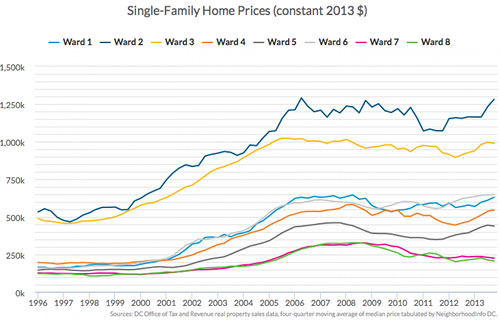How fast housing in DC is growing unaffordable, in 3 charts
Everyone not living under a rock knows that DC is booming with huge demand for people to live here. It’s also a well-accepted fact that this trend is squeezing out the poorer residents. A new report from the Urban Institute graphs just how strong this effect is.
For renters, the amount of available housing that costs $1,000 a month or more has increased, while housing at lower price points has shrunk.
Here’s another graph showing how for all housing sizes, the available inventory of rental units except for the already-scarce 3-bedrooms has shrunk for all lower-income categories.
Single-family homes shot up in price before the recession, somewhat sooner in the wealthiest wards, 2 and 3, and slightly after that in other wards. Housing east of the Anacostia has fallen since 2009. In 4 and 5, it fell but then recovered, while in the rest of the city it stayed stable even through the recession, when housing prices collapsed most everywhere else in the nation.
As the report says, a lot of this change comes from new residents who are primarily younger (67% are 18-34 years old), highly education (65% have bachelor’s or graduate degrees), and made more money. New residents were more likely not to have children than existing residents.
Given that new people are coming into the city, it’s understandable that some see the new residents as a threat and don’t want changes, like allowing car-free buildings or accessory apartments, that can accommodate them. But it’s a mistake to see new residents as an enemy, since they are going to come in regardless, and will be able to outbid many existing residents for housing.
The question is how to build a city that can welcome new residents of all income levels while also continuing to serve existing ones. But how?
It’s not that DC isn’t building a lot of housing. Is it enough? Supporters of a housing supply-focused approach say the city just needs to make sure it’s building even more housing to keep up with demand. If you build so much higher-end housing to saturate that market, then lower-end housing won’t rise in price.
Alternatively, skeptics of this approach worry it’s not possible to build enough housing, and perhaps there’s an induced demand effect where more new housing just makes the city even more attractive. Therefore, it may also be necessary to establish and strengthen programs that guarantee a segment of new and existing housing remain affordable.
But even those programs have a limit on how much money the city can put in and how many units they can create amid this rapid run-up in price. So far, we don’t seem to have a good answer. Nobody wants a city that’s so undesirable people stop wanting to live here, but neither do we want one that’s off-limits to anyone with a lower income.



